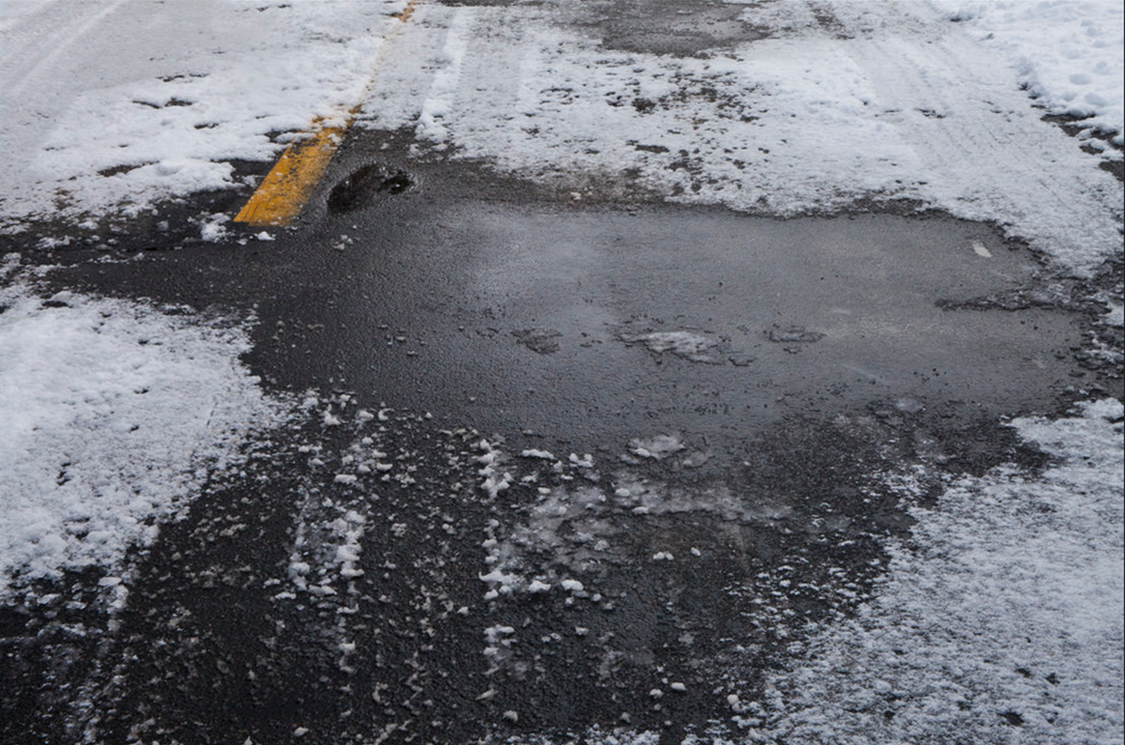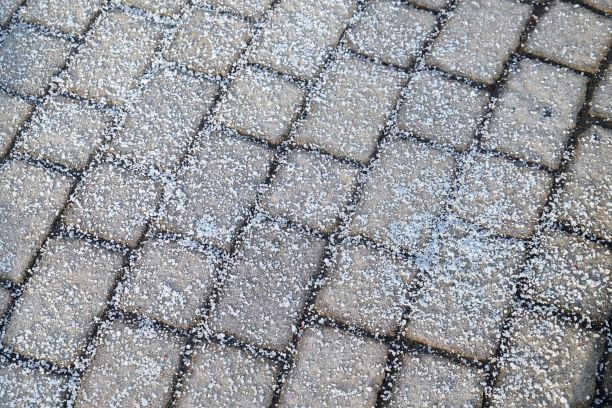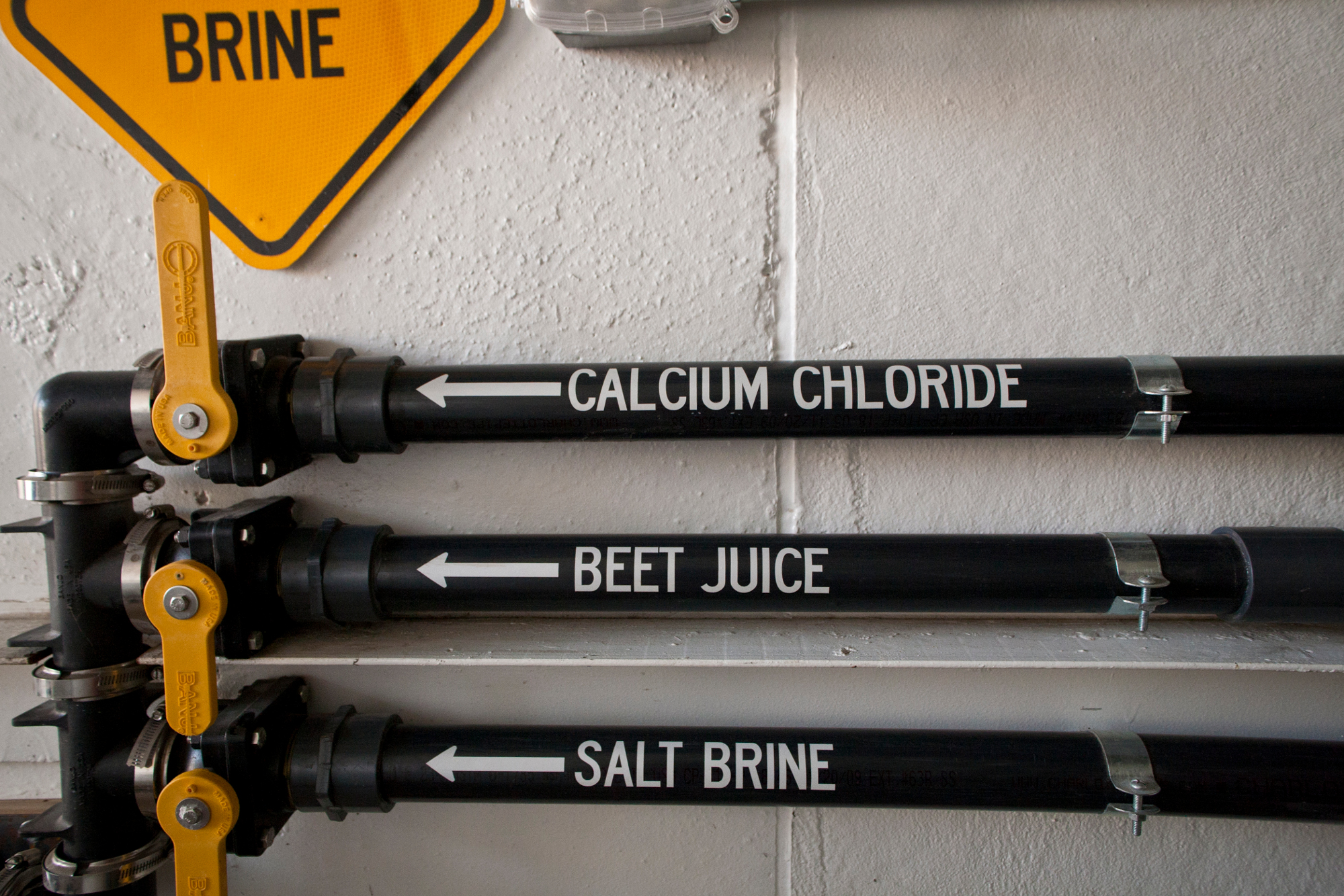

The United States utilized approximately fifteen billion kilograms of road salt during the winter of 2013-2014. The removal of snow has evolved over the years from mechanical approaches such as shoveling and plowing to heating to chemical methods, including deicing substances (U.S. Patent No. 4664832A, 1984). Deicers, which are based on lowering the freezing point of water, are applied after snow events (Charola, Rousset, & Bläuer, 2017). There is no “perfect” deicing substance on the market today because there are numerous needs for one product, including solubility with water, efficient in low temperatures, long-lasting, convenient, cost effective, and reliable (U.S. Patent No. 6416684B1, 2001). While some products are environmentally friendly, they are expensive and hard to manage at home and while others are inexpensive, they corrode automobiles and create slick conditions.


Source (Left to Right): https://www.deeproot.com/blog/blog-entries/deicing-with-beet-juice, https://pprc.org/2015/p2-rapid/how-to-reduce-the-environmental-impact-of-deicing/
From a statewide perspective, total economic impact also plays a role in deciding the type of deicing substance to use (U.S. Patent No.4664832A, 1984). The US Environmental Protection Agency published data stating that the cost of damage from using sodium chloride rock salt for highway deicing is about 15 times the actual cost of purchasing and applying the salt in the first place (U.S. Patent No. 4664832A, 1984). Additionally, the environmental impacts of many deicing substances on the market today are substantial and can cause corrosion, slick conditions on the road, and water pollution (Dai, Xhang, Xu, & Yu, 2012). As a result, the main goal is to find the best product depending on preference to cost, availability, environmental effects, toxicity, and effectiveness in low temperatures.
Freezing point depression is a type of colligative property: a physical property that is not dependent on size, mass, or other parts of the solute particles in a solution (World of Chemistry, 2000). A freezing point of a solution is when the temperature of vapor pressure is equal to the temperature of the solid. Adding a substance that does not easily evaporate into gas into the solvent will lower the vapor pressure and consequently, lower the temperature where the vapor pressure of the liquid and solid is equal (World of Chemistry, 2000). For example, as salt dissolves in water as a deicer, it lowers the freezing point of water several degrees, preventing ice from forming on the streets (World of Chemistry, 2000).
There are two major kinds of deicing chemicals on the market today: organic chemicals with potassium acetate and chlorate (Dai et al., 2012). Organic chemicals are efficient non-corrosive but expensive to use as a complete solution (Dai et al., 2012). Deicing depends on the properties of solutes to lower the melting point when dissolved (Dunn and Schenk, 1979). The lower the molecular weight, the lower the freezing point will decrease (Dunn and Schenk, 1979). Chlorate, which include sodium chloride (NaCl) and calcium chloride (CaCl2) and generally called deicing salts, is low cost but produces increased breakage (Dai et al., 2012).


Sources (Left to Right): https://cen.acs.org/articles/93/i2/Periodic-Graphics-Deicers-Antifreeze.html; https://www.oregon.aaa.com/2017/02/aaa-salt-and-chemical-de-icers-cost-drivers-3-billion-annually/
Ice and snow can melt faster using deicing chemicals but there are serious consequences for the environment from excessive use. Chemicals in melted snow can make their way into the soil by surface water or underground water and stay there, polluting the environment (Dai et al.,2012). These chemicals could also get absorbed by plants and impact plant growth, as well as absorbed by particles in the air and get transported to a new location (Dai et al., 2012). Other environmental effects of deicers include changing the physical and ecological properties of lakes, polluting drinking water by increasing salinity, damaging the ozone layer, and disturbing the balance in plant cells. Sodium chloride is responsible for the corrosion of bridges, road surfaces, vehicles, and the damage to vegetation and aquatic systems (Amrhein, Strong, & Mosher, 1992).



The right photo is the effect of sodium chloride on high way vegetation.
Sources (Left to Right): https://stormwater.pca.state.mn.us/index.php?title=How_salt_works_and_overview_of_deicing_chemicals; http://www.copecompany.com/snow-management-industry-articles/liquid-deicer-vs-salt/
During the winter of 2002 in Beijing, many people spread large quantities of deicing chemicals to melt all the snow. The next spring, over 300 thousands living green fences died. According to Dai (2012), “After testing the left snow near (the) main roads and soil around the injured or dead plants, it was found that salt content in soil was 392 times higher than the normal value.” Canadian and northeastern US states also measured sodium content in well reservoirs at levels 2-140 times the recommended limit for people (Amrhein et al., 1992). As a result, many more alternatives to NaCl have been found and commercially used.
One promising solution is calcium magnesium acetate (CMA). While NaCl has sodium ions present, CMA does not, which produces little to none corrosive effects (U.S. Patent No. 4664832A, 1984). Although, CMA takes 20-30 minutes to start melting snow, it is longer lasting that road salt and only needs to be applied once in 12 hours (Kelting & Laxson,2010). However, when CMA gets absorbed by soil, its microbes will break down the acetate ions and deplete oxygen levels which can impact plant life (Charola et al., 2017). Similarly, oxygen depletion could happen in slow moving streams and small ponds where the acetate ions could migrate (Charola et al., 2017). Additionally, CMA is associated with low molecular weight alkaline earth salts produced from waste by alkaline fusion (Dunn and Schenk, 1979). Different from NaCl, CMA releases heat when going into a water solution instead of absorbing heat, which speeds up melting (Dunn and Schenk, 1979).
Purified CMA is often applied with NaCl which works to increase traction if the solution is unable to work through a sheet of ice (Dunn and Schenk, 1979). If CMA is taken without purification, traction improves meaning that a purification step is potentially not needed. This could lead to a better CMA deicer at a lower cost. Although CMA has positive environmental effects, the deicer is produced by classical chemical methods using pure chemicals (U.S. Patent No. 4664832A, 1984) which results in expensive costs. Some suggestions have been made for CMA to made in a crude form of acetic acid by reacting cellulose with an inorganic base, however, this process produces significant amounts of oxalic acid which is toxic to humans (U.S. Patent No. 4664832A, 1984).

Source: https://www.deeproot.com/blog/blog-entries/deicing-with-beet-juice
Another promising solution is beet juice from desugared sugar cane molasses. Desugared molasses from beet juice is often discarded after the useful sugar is removed (U.S. Patent No. 6416684B1, 2001). Minnesota Department of Transportation started to use beet juice as a deicer from the large industry in the Red River Valley of Minnesota and the need of re-use of sugar beet waste (Charola et al., 2017). Typically, beet juice syrup is mixed with traditional salt, sand, or chloride brines (Charola et al., 2017). Beet juice is readily soluble as well as improves the properties of other deicers (U.S. Patent No. 6416684B1, 2001). When beet juice is combined with other deicers, a smaller amount of chemicals is needed to do the same amount of work, resulting in a smaller environmental impact. Beet juice itself is highly effective at temperatures below 0°C and is non-corrosive and environmentally friendly (Gerbino et al., 2012).
It does not harm vehicles or outdoor structures and similarly to CMA, when combined with other deicing compounds, beet juice reduces the corrosiveness of the solution (U.S. Patent No. 6416684B1, 2001). Scientists are also researching other waste products as an alternative to combine with NaCl. Residues of distilled or fermented agricultural products like corn, barely, and pickle brine or other ideas like wet corn milling, wine, and cheese-making are potential solutions to cost effective alternatives.
Currently, the “best” deicer does not exist. All different deicing substances have their advantages and disadvantages. Scientists are researching chemicals in relation with infrastructure, roads, bridges, and environment to find multiple solutions to the increasingly widespread issue of deicing substances’ impact on the environment. NaCl is effective at lowering the freezing point of water however NaCl breaks down soil structure and could contaminate drinking water (Kelting & Laxson, 2010).
Many alternatives with promising solutions have been proposed such as calcium magnesium acetate and beet juice, however cost and availability made it hard for governments to switch to using environmentally friendly deicers. While CMA has little to no adverse effects on the environment, it costs about 30 times more than NaCl by the ton. Additionally, while beet juice is cost-effective and efficient, the production is only in certain parts of the United States. Homeowners also have to decide on the best deicer that suits most, if not all, of their needs. While some deicers are animal and eco friendly, they could create dangerous conditions on the roads. If homeowners purchase a cost-effective solution, corrosion could occur on cars and sides of houses. The search for the perfect deicer still continues statewide and in everyday homes. As snowfall comes earlier year by year, the need for an environmentally friendly solution becomes more pressing. Innovative solutions such as installing heated solar panels on roads present promising results yet lack the funding to continue. Maybe scientists should not be looking for the perfect deicing substance but rather a combination of the most cost-effective, reliable, and environmentally friendly deicing substances.
|
|
-9°C | -32°C | -5°C | -17°C |
|
|
$42 | $140 | $1,492 | N/A |
|
|
Breaks down soil structure and decreases permeability | Forms complexes with heavy metals and increases soil mobility | Improves soil structure but could release heavy metals | Little to no effect |
|
|
Increases the risk of drinking water contamination | Increases the risk of metal contamination | Increases the risks of heavy metals getting released | Depletes dissolved oxygen in water |
|
|
Causes osmotic stress and nutrient imbalance | Causes osmotic stress and leaf scorch | Little to no effect, could cause osmotic stress at high levels | Little to no effect |
|
|
Causes salt toxicosis in birds, increases driving accidents (animals are attracted to salt) | Little to no effect | Little to no effect | Adds sugar to aquatic ecosystems which causes bacterial growth |
|
|
Accelerates corrosion of exposed metal reinforcement bars | Surfaces stay wet longer causing slick conditions | Increases metal corrosion | Non-corrosive |
Amrhein, C., Strong, J. E., & Mosher, P. A. (1992). Effect of deicing salts on metal and organic matter mobilization in roadside soils [electronic version]. Environmental Science & Technology, 26(4), 703–709. doi: 10.1021/es00028a006
Kelting, D. L., & Laxson, C. L. (2010). Review of Effects and Costs of Road De-icing with Recommendations for Winter Road Management in the Adirondack Park. (pp. 1–19). Paul Smiths, NY: Adirondack Watershed Institute.
Charola, A. E., Rousset, B., & Bläuer, C. (2017). Proceedings of the 4th International Conference on Salt Weathering of Buildings and Stone Sculptures, 16–23. Retrieved from https://repository.si.edu/handle/10088/34482
Colligative properties. (2000). In World of Chemistry. Detroit, MI: Gale. Retrieved from https://link.gale.com/apps/doc/CV2432500179/SCIC?u=mlin_s_thomas&sid=SCIC&xid=a0186634
Dai, H., Zhang, K., Xu, X., & Yu, H. (2012). Evaluation on the effects of deicing chemicals on soil and water environment [electronic version]. Procedia Environmental Sciences, 13, 2122–2130. doi: 10.1016/j.proenv. 2012.01.2010
Dunn, S. A., & Schenk, R. U. (1979). Alternative Highway Deicing Chemicals. Transportation Research Board Special Report, (185), 261–269. Retrieved from http://onlinepubs.trb.org/Onlinepubs/sr/sr185/185-043.pdf
Gerbino-Bevins, B. M., Tuan, C. Y., & Mattison, M. (2012). Evaluation of ice-melting capacities of deicing chemicals [electronic version]. Journal of Testing and Evaluation, 40(6),104460. doi: 10.1520/jte104460